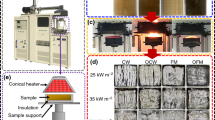Abstract
In the Great East Japan Earthquake on March 11, 2011, large amounts of disaster waste were generated by the earthquake and subsequent tsunami. Much of the mixed wood waste was stored in a temporary storage facility for an extended period of time, and fire broke out due to spontaneous ignition. Consequently, it is now the practice that when a metropolitan epicentral earthquake occurs, disaster waste will be generated and stored locally. Fire caused by the same type of spontaneous ignition is a grave cause for concern. Thus, in order to prevent such fires, we evaluated the thermal behavior of the oxidation heat of the wood that was believed to be the cause of the heat generation in disaster waste. As a result of studies using TG–DTA and TAM, it was revealed that the thermal danger of wood increases due to increases in the temperature and in the concentration of unsaturated fatty acids in the wood. It is thought that the oxidation heat of the unsaturated fatty acids contained in the waste wood contributed to heat generation near 70 °C after heat generation by fermentative bacteria.




Similar content being viewed by others
References
Murasawa N, Koseki H, Iwata Y, Suzuki K, Tamura H, Sakamoto T. Investigation of the heat generation and spontaneous ignition of disaster waste generated after the 2011 Great East Japan Earthquake. Fire Saf J. 2013;59:178–87.
Li XR, Koseki H, Momota M. Evaluation of danger from fermentation-induced spontaneous ignition of wood chips. J Hazard Mater. 2006;135(1–3):15–20.
Iwata Y. Thermal risk and evaluation of recycled material fuel. Saf Eng. 2012;39(1):21–5 (in Japanese).
Hernadez-Atonal FD, Ryu C, Sharifi VN, Swithenbank J. Combustion of refuse-derived fuel in a fluidized bed. Chem Eng Sci. 2007;62:627–35.
Fu Z, Koseki H, Iwata Y. Investigation on spontaneous ignition of two kinds of organic material with water. Thermochim Acta. 2006;440:68–74.
Li XL, Lim W, Iwata Y, Koseki H. Thermal characteristics and their relevance to spontaneous ignition of refuse plastics/paper fuel. J Loss Prev Process Ind. 2009;22:1–6.
Shimizu Y, Wakakura M, Arai M. Heat accumulations and fire accidents of waste paper. J Loss Prev Process Ind. 2009;22:86–90.
Sakka M, Kimura T, Sakka K. Comparison of microbial consortia in refuse-derived fuel (RDF) preparations between Japan and Germany. Biosci Biotechnol Biochem. 2006;70:2868–73.
Nakayama J, Miyake A. Catalytic effect of copper (II) oxide on oxidation of cellulosic biomass. J Them Anal Calorim. 2012;110:321–7.
Nakayama J, Miyake A. Thermal and evolved gas analyses of the oxidation of a cellulose/copper(II) oxide mixture. J Them Anal Calorim. 2013;113:1403–8.
Migita N. Wood chemistry. Tokyo: Kyoritsu Shuppan Co; 1968 (in Japanese).
Kitao K. Component distribution in the wood. Materials. 1963;12(121):51–7 (in Japanese).
Yasuda K. Knowledge of the oil and fat products. Tokyo: SAIWAI SHOBOC Co; 1999 (in Japanese).
Japan Oil Chemist’s Society. The handbook of oil chemistry—liquids and surfactants. 4th ed. Tokyo: Maruzen Company, Limited; 2001 (in Japanese).
Koseki H, Iwata Y, Momota M, Li X.R. Summary of the wood chip fire and evaluation tests for danger depending on spontaneous ignition of wood chips by various thermal analysis. Report of National Research Institute of Fire and Disaster. 2007;103: 36–41. (in Japanese).
Murasawa N, Koseki H, Iwata Y, Sakamoto T. Risk assessment of woody biomass fuels and waste using hight-sensitivity calorimetry and gas chromatography. Waste Biomass Valoriz. 2014;5:223–33.
Friedman HL. Kinetics of thermal degradation of char-forming plastics from thermogravimetry. Application to a phenolic plastic. J Polym Sci Part C. 1963;6:183–95.
Roduit B, Borgeat C, Berger B, Folly P, Andres H, Schädeli U, Vogelsanger B. Up-scaling of DSC data of high energetic materials. J Therm Anal Calorim. 2006;85:195–202.
Acknowledgements
The authors express their thanks to the Fire Technology and Safety Laboratory of Tokyo Fire Department for their help and support in performing experiments.
Author information
Authors and Affiliations
Corresponding author
Rights and permissions
About this article
Cite this article
Mizuta, R., Izato, Yi. & Miyake, A. Thermal ignition behavior of waste woods mixed with unsaturated fatty acids. J Therm Anal Calorim 121, 361–369 (2015). https://doi.org/10.1007/s10973-015-4788-5
Received:
Accepted:
Published:
Issue Date:
DOI: https://doi.org/10.1007/s10973-015-4788-5




